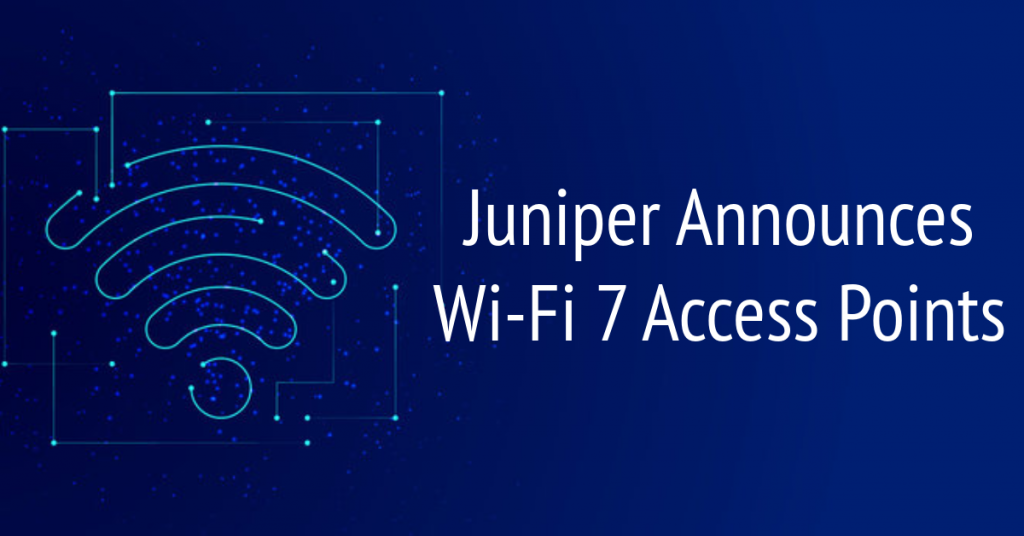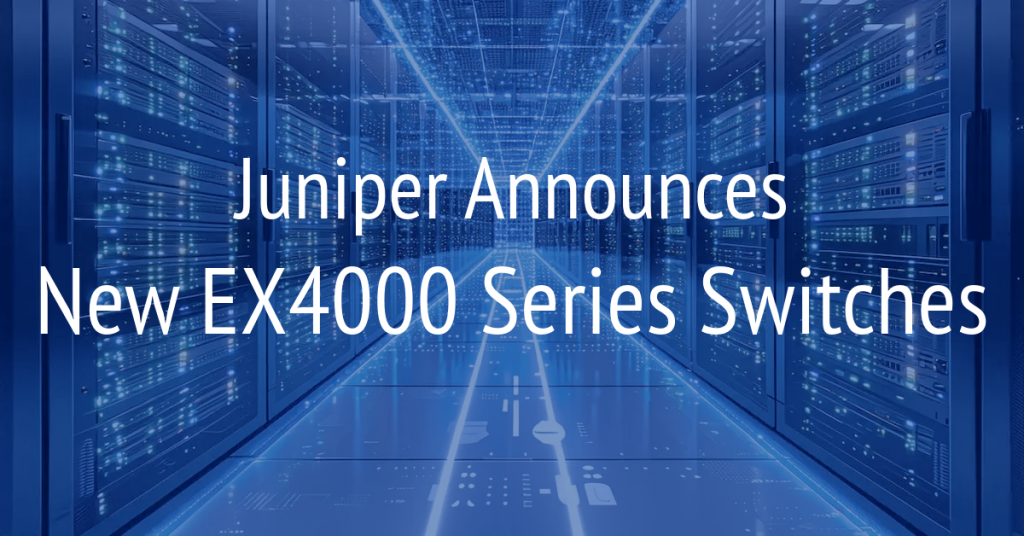
Juniper Announces Wi-Fi 7 Access Points
Juniper recently announced several additions to its wired and wireless portfolio that will allow its customers to take advantage of the new Wi-Fi 7 standard. Among them is the new Wi-Fi 7 certified AP47. But before we talk about the access point features, let’s start with a bit of background about the Wi-Fi 7 standard.
What is Wi-Fi 7?
Wi-Fi 7 is the WiFi® Alliance’s name for the next generation of wireless technology. It corresponds to the IEEE’s 802.11be standard. This standard, named Extremely High Throughput (EHT), builds upon the previous 802.11ax standard. This new standard has a variety of new technology features focused on delivering higher throughput on wireless networks. These features allow for a theoretical throughput of up to 46 Gigabits per second (Gbps). While real-world numbers will likely be much lower than this, it is still a huge increase over even Wi-Fi 6E.
The standard is *technically* not fully ratified by the IEEE yet (though it’s very close!), but that hasn’t stopped manufacturers from releasing products. We started seeing “Wi-Fi 7” products announced as early as 2022, but the Wi-Fi Alliance didn’t begin certifying devices for Wi-Fi 7 until January 2024. Since then, we’ve seen many larger enterprise networking companies release Wi-Fi 7 APs. Juniper has now announced their flagship Wi-Fi 7 APs (and I’m sure there will be more models in the future!). Personally, I MUCH prefer this. Because, while the IEEE standard has not been completely finalized, the last couple of things they are going around on are relatively minor, and most of the standard has been completed.
While we already saw Android-based devices that included Wi-Fi 7, Apple recently announced the new iPhone 16 will include Wi-Fi 7. Many people have said in the past that Wi-Fi technology adoption follows the clients. And with both major mobile device OS vendors pushing towards Wi-Fi 7, I expect we’ll see a significant jump in adoption.
What about those APs?!
Rather than making this all about Wi-Fi 7, let’s talk about these new APs. These new APs continue the scaled approach Juniper has taken to expanding their product lines. Rather than having a lot of new APs with a plethora of models, today, we see three new flagship APs being announced by Juniper. Two of them are the type we’re used to seeing: a built-in omnidirectional antenna model, and an external antenna model. The third brings a newer option to the table that we’ve seen from some other manufacturers: a built-in directional antenna model. This directional model can greatly simplify the deployment by not requiring an external antenna. The current model is a 60-degree by 60-degree directional antenna.
Let’s talk features
As the flagship AP, these new models pack in the features. Here are the highlights:
- Quad Radio
The AP47 lineup is all quad radio with three 4×4:4 serving radios and the fourth a 2×2:2 tri-band scanning radio. I like that Mist has held this flagship to 4×4. While some other manufacturers have released massive 8×8 APs, I don’t think the uplift in streams end up being “worth it” overall compared to a 4×4 in most cases. And I can’t understate the importance of the dedicated scanning radio. This extra radio allows for additional functionality without taking away from the client serving radios. - Multiple Radio Operating Modes
As we saw with previous generation Mist flagship APs, the AP47s will have multiple modes of operation. These modes change the radios’ frequency bands, allowing the AP to adapt to a changing RF environment. In the AP45, the 2.4 GHz serving radio could also serve 5 GHz. This allowed the AP45 to be dual 5, where two radios were serving 5 GHz, and the 3rd was serving 6 GHz. In the AP47, Mist has expanded on this, allowing a dual 6 mode in addition to the dual 5 mode. This can come into play as more clients move to the 6GHz band. Now that the penetration on the client side for 6GHz is there, by changing the modes on these APs, you can get a longer life out of the APs. Where this gets interesting is that Mist’s automated Radio Resource Management (RRM) can dynamically switch these modes. - Expanded location services and Internet of Things (IoT) support Mist’s patented Bluetooth antenna array has long been a huge selling point for using their location services. This array, and the accompanying virtual Bluetooth Low Energy (BLE) virtual beacon technology, allow a Mist network to provide location services without separate hardware beacons or complicated and time-consuming calibrations. And in the AP47, this stays true. Along with upgrading the BLE radio to the latest 5.4 version , Juniper also added additional radios for IoT support. Initially, we’ll see support for Ultra-Wide Band (UWB). They have also built-in a second 802.15.4 radio which can support Thread, Matter, and Zigbee. These protocols are used in IoT networks, and including them in infrastructure APs should help expand these networks without needing additional devices. There is also GPS on board for Automatic Geo Location and Automated Frequency Coordination (AFC).
- Dual 10G interfaces
The AP47 comes with two 10Gbps interfaces with multi-gig support. With the ability for 46Gbps of theoretical throughput, even a single 5Gbps uplink interface wouldn’t be enough. We’ve seen other manufacturers include dual uplink and even dual multi-gig, but not many have jumped to dual 10Gbps. This ability to use the second interface as an uplink for the AP is new. But we will see the same ability as previous Mist APs, where the second interface can be used as an uplink for other devices, though they will not pass Power over Ethernet (PoE) through. - PoE upgrades
The AP47 requires 802.11bt power. We also saw this requirement in the AP45. Initially, the dual interfaces on the AP will provide “hitless PoE failover,” so if both interfaces are connected to a PoE switch, the AP won’t reboot if a switch goes offline. - AI for Wi-Fi 7
While with Mist this is “assumed,” in this age of AI washing, it does warrant highlighting. As part of the hardware upgrades, the Mist AI models will be upgraded to help support Wi-Fi 7 features, specifically troubleshooting and digging into issues that are “Wi-Fi 7 specific” rather than just wireless. So our friend Marvis who we’ve come to rely on will get additional language, actions, and feedback on Wi-Fi 7 separate from other protocols.
These new AP47s from Juniper show that Juniper is not only keeping the table stakes of Wi-Fi 7 support, but also bringing new functionality to their APs. The inclusion of UWB, plans for additional IoT protocol support, dual PoE, an internal directional model, and looking towards the future with dual 6Ghz operation, shows that Juniper is trying to prevent some of the pitfalls of early adoption. And that’s before we apply the entire platform that Juniper always brings to the table. By enhancing Marvis for Wi-Fi 7, they will continue bringing the quality data we’ve grown to expect from Mist to the forefront, making our lives easier as we deploy more complicated networks.
Next Steps
If you’re interested in talking about what Wi-Fi 7 can do you for you or considering a wireless upgrade, Nexum has multiple wireless engineers who would be happy to talk to you about the technology differences, look at your current network, and make some recommendations. Drop us a line through our Talk with an Expert form here, and we’ll help you find your best path forward.
Check Out More Resources

Juniper EX4000
Nexum’s, Allyn Crowe, breaks down what sets the latest EX4000 series switch apart—powerful PoE, multigig support for next-gen Wi-Fi, and faster performance. With quick boot times and seamless upgrades, it’s a smart choice for future-proofing networks.

AI-Native Now
Join Juniper Networks on June 5th for a LinkedIn Live exclusive discussion on “Leveraging AIOps for Maximum Impact.”

Wireless LAN Professionals Conference 2024
Allyn Crowe, Senior Security Engineer, attended the Wireless LAN Professionals conference. If you work on wireless networks, you really need to try and get to this conference.


